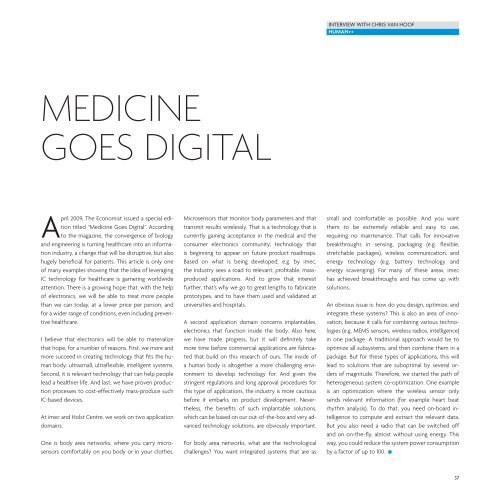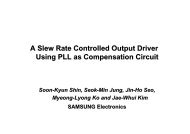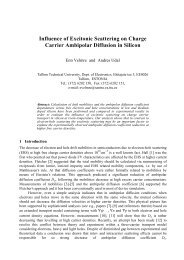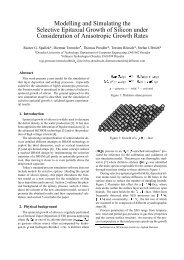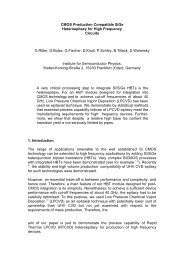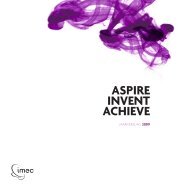Annual report 2009 - Imec
Annual report 2009 - Imec
Annual report 2009 - Imec
You also want an ePaper? Increase the reach of your titles
YUMPU automatically turns print PDFs into web optimized ePapers that Google loves.
mEDICINE<br />
gOES DIgITAL<br />
April <strong>2009</strong>, The Economist issued a special edition<br />
titled “Medicine Goes Digital”. According<br />
to the magazine, the convergence of biology<br />
and engineering is turning healthcare into an information<br />
industry, a change that will be disruptive, but also<br />
hugely beneficial for patients. This article is only one<br />
of many examples showing that the idea of leveraging<br />
IC technology for healthcare is garnering worldwide<br />
attention. There is a growing hope that, with the help<br />
of electronics, we will be able to treat more people<br />
than we can today, at a lower price per person, and<br />
for a wider range of conditions, even including preventive<br />
healthcare.<br />
I believe that electronics will be able to materialize<br />
that hope, for a number of reasons. First, we more and<br />
more succeed in creating technology that fits the human<br />
body: ultrasmall, ultraflexible, intelligent systems.<br />
Second, it is relevant technology that can help people<br />
lead a healthier life. And last, we have proven production<br />
processes to cost-effectively mass-produce such<br />
IC-based devices.<br />
At imec and Holst Centre, we work on two application<br />
domains.<br />
One is body area networks, where you carry microsensors<br />
comfortably on you body or in your clothes.<br />
Microsensors that monitor body parameters and that<br />
transmit results wirelessly. That is a technology that is<br />
currently gaining acceptance in the medical and the<br />
consumer electronics community; technology that<br />
is beginning to appear on future product roadmaps.<br />
Based on what is being developed, e.g. by imec,<br />
the industry sees a road to relevant, profitable, massproduced<br />
applications. And to grow that interest<br />
further, that’s why we go to great lengths to fabricate<br />
prototypes, and to have them used and validated at<br />
universities and hospitals.<br />
A second application domain concerns implantables,<br />
electronics that function inside the body. Also here,<br />
we have made progress, but it will definitely take<br />
more time before commercial applications are fabricated<br />
that build on this research of ours. The inside of<br />
a human body is altogether a more challenging environment<br />
to develop technology for. And given the<br />
stringent regulations and long approval procedures for<br />
this type of applications, the industry is more cautious<br />
before it embarks on product development. Never-<br />
theless, the benefits of such implantable solutions,<br />
which can be based on our out-of-the-box and very advan<br />
ced technology solutions, are obviously important.<br />
For body area networks, what are the technolo gi cal<br />
challenges? You want integrated systems that are as<br />
INTERVIEW WITh chRIs VaN hoof<br />
HUMAN++<br />
small and comfortable as possible. And you want<br />
them to be extremely reliable and easy to use,<br />
requiring no maintenance. That calls for inno va tive<br />
break throughs in sensing, packaging (e.g. flexible,<br />
stretch able packages), wireless communication, and<br />
energy technology (e.g. battery technology and<br />
en er gy scavenging). For many of these areas, imec<br />
has achie ved breakthroughs and has come up with<br />
solutions.<br />
An obvious issue is: how do you design, optimize, and<br />
integrate these systems? This is also an area of innovation,<br />
because it calls for combining various technologies<br />
(e.g. MEMS sensors, wireless radios, intelligence)<br />
in one package. A traditional approach would be to<br />
optimize all subsystems, and then combine them in a<br />
package. But for these types of applications, this will<br />
lead to solutions that are suboptimal by several orders<br />
of magnitude. Therefore, we started the path of<br />
heterogeneous system co-optimization. One example<br />
is an optimization where the wireless sensor only<br />
sends relevant information (for example heart beat<br />
rhythm analysis). To do that, you need on-board intelligence<br />
to compute and extract the relevant data.<br />
But you also need a radio that can be switched off<br />
and on on-the-fly, almost without using energy. This<br />
way, you could reduce the system power consumption<br />
by a factor of up to 100.<br />
37


